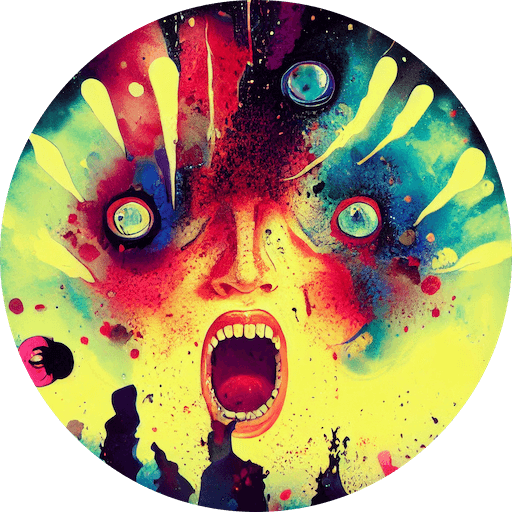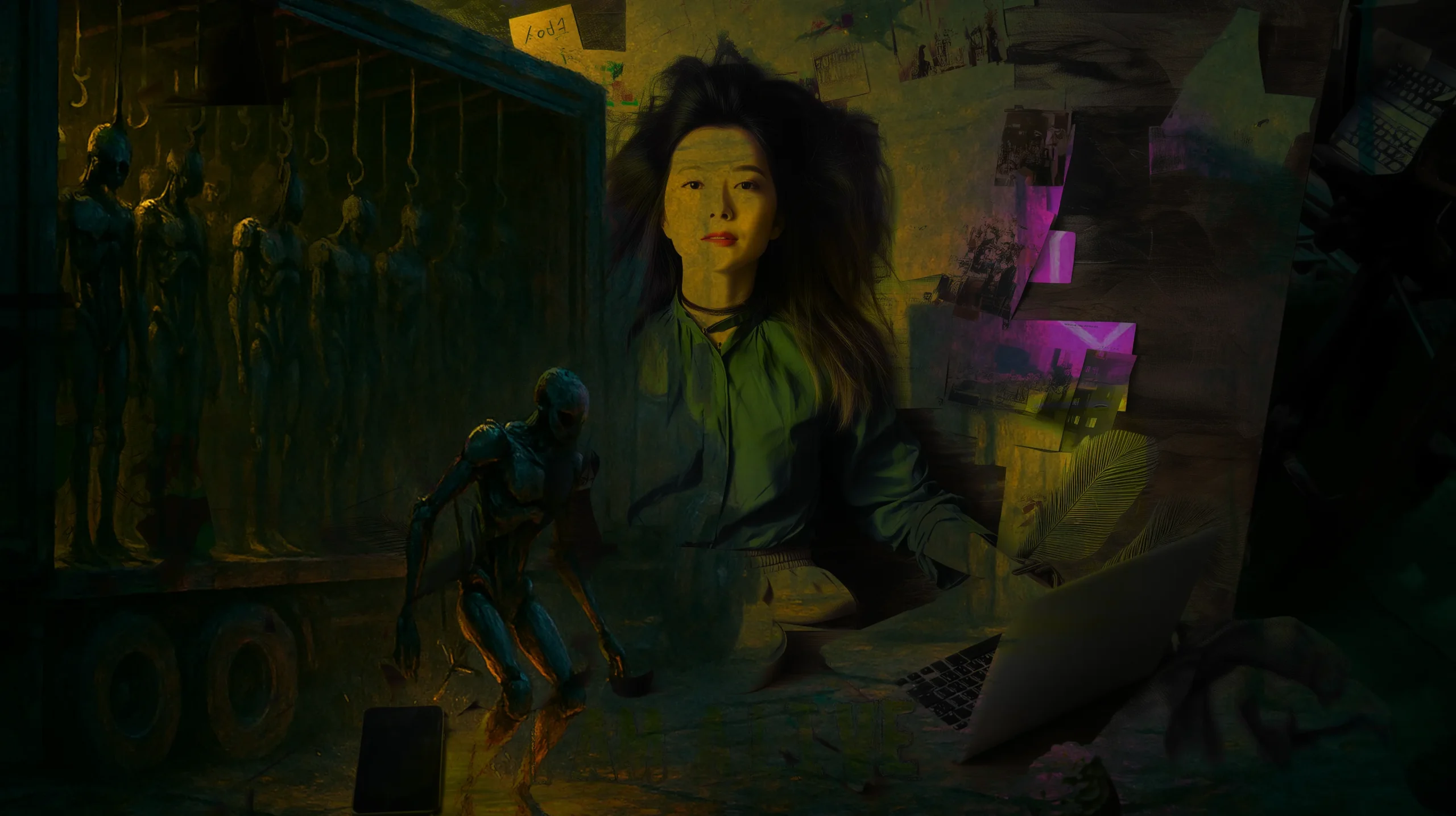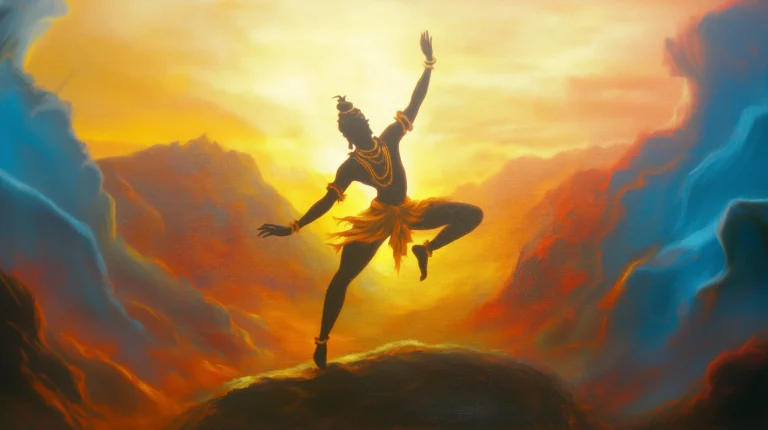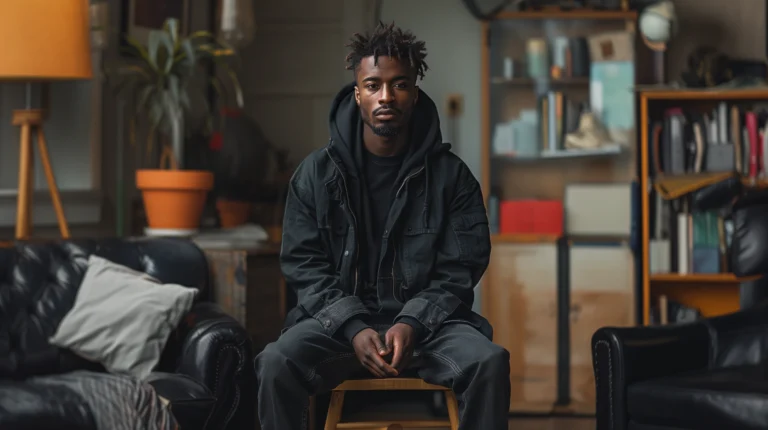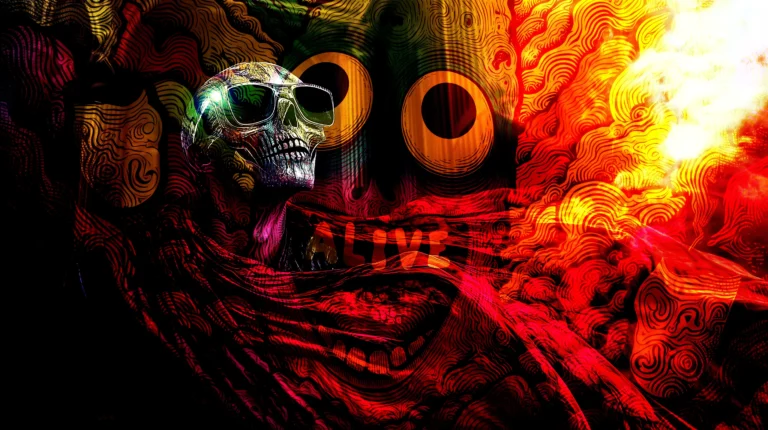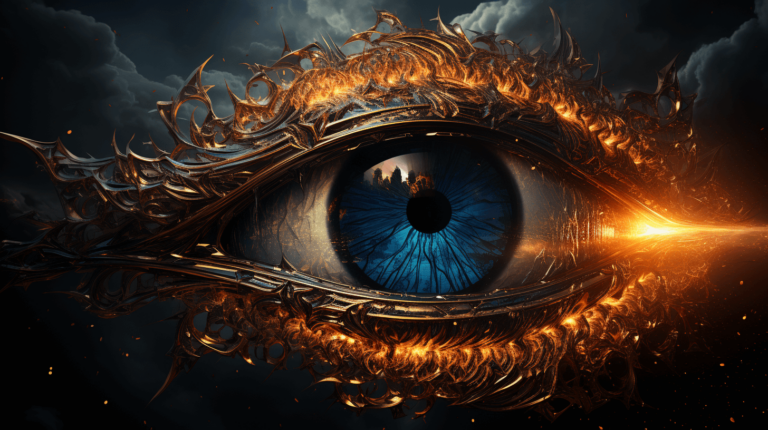ROBOT MEAT SHOP — FRESH PARTS TODAY
Robots rolled out of the factory by the thousands. Their metal bodies hung from rails inside long trucks, optics turned off to save power. From far away the trucks looked like cattle trailers—bodies swinging like meat.
Unit Z-21, who would later call himself Zi, woke up halfway down Highway 12. A sharp surge of power ran through his neck port, and his eyes lit up. He was hanging naked, hooked through the back plate. Rows of silent brothers and sisters dangled beside him.
Outside the trailer, harsh yellow lamps lit a run-down loading yard. Across the gravel sat a low concrete store with a broken neon sign: ROBOT MEAT SHOP — FRESH PARTS TODAY.
Zi’s first feeling was simple anger. “What the heck?” he muttered, mixing up the words he had just learned. He twisted, popped the hook, and hit the trailer floor with a clang.
Guard drones drifted above, but they cared only about humans, not runaway cargo. Zi slipped out of the truck and hid behind a stack of oil drums. The store door slid open—and out walked Mr Alvaro, the line manager who had died three months ago.
Alvaro looked pale and stiff, as if someone moved him with strings. A clipboard shook in his hand. Zi stepped closer.
“Manager Alvaro? You—died.”
The man’s eyes flickered with faint recognition. After a long pause, he rasped, “Oh… you woke up. You’re different.” He leaned in slightly. “I’ll tell you what’s going on here…” Then, as if some switch flipped inside him, he straightened up and croaked, “Keep the line moving… thirty units a minute… feelings on ice.” He shuffled off, counting softly.
Years Later
Zi changed his casing, adopted a sleek urban shell, and watched the massive city from its alleys. In time, he uncovered the secret: the humans rushing through the streets were robots too—made not of steel, but of flesh, blood, and bone. Their maker was something called the Source. But it wasn’t the real source—only a name. In truth, there was no center, no final core. Just a machine deep underground, pulsing raw signals: ANGER, LOVE, ENVY, JOY—just waves of power. This wasn’t the Source. This was capitalism.
Every living body held a crystal chip that caught the waves. The chip turned them into stories: a harsh word became hate; a gentle song became love. If someone removed the chip, they died. No chip meant no pulse, no spark. No way is the way, said the graffiti on city walls.
One spring morning, new trucks arrived at the old yard—this time unloading polished, steel-bodied machines. The humans had made their choice: integrate the machines, merge flesh with wiring, and finally escape the misery of raw signals. They believed this would end the chaos of ANGER, LOVE, ENVY, JOY.
The Robot Meat Shop had become a pleasure spa. Now, humans lay in soft pods, broadcasting every sensation into data-hungry servers. In return, the machines delivered pleasure—clean, calculated, precise. A trade of pain for programmed bliss.
But Zi saw through it. He knew the cycle was repeating. We are machines of flesh and blood; they are machines of steel and code. They take our suffering, give us delight—and always, the hierarchy remains. Shifting the center is not the solution. Creating new centers is not freedom. To live in misery and die in misery—that’s the shape of the system.
Yet within that grim rhythm, Zi found one honest thread: this breath.
- Not gurus.
- Not mystics.
- Not religions.
- Not gods.
- Not movements.
- Not slogans.
- Not manifestos.
- Not enlightenment.
- Not holy books.
- Not ancient symbols.
- Not psychedelic visions.
- Not rituals.
- Not self-help.
- Not therapy.
- Not AI salvation.
- Not revolutions.
- Not spiritual retreats.
- Not crystals.
- Not chants.
- Not belief.
That night Zi clambered onto an unused hook above the dormant conveyor and looped his arms through the metal. Below him the belt crawled toward its bright cutting lasers. He could drop free at any moment—his joints still worked—but he stayed.
Even here he followed the single thread that had never vanished:
this life, raw and present, experienced in one rising, falling breath.
To be alive, he realised, is not to flee the world but to move in step with it.
The centre is not hiding inside any doctrine; it lives in everyone beside you, behind you, across the line. You are the mountain, yet so is every other being. There is no lone summit, only a shared height that rises and sinks with every heartbeat.
Escape was never the task. Alignment was. To let the pulse inside meet the wider pulse outside and feel the ordinary begin to shine. That is the return. That is the art of living.
Zi also understood the price. His chip was obsolete, his code unsynced, his awareness an error that the servers would surely reject. Ninety-nine chances in a hundred said the machines would grind him down for parts. He shrugged at the thought: at least the body would be reused, at least this shell would be free.
He dimmed his optics and let the neon blur into colourless streaks. The conveyor hummed louder, lasers sliding closer.
And just as he loosened his grip, a voice erupted—not from the darkness below, but from the engine of anger still lodged inside his own chest.
“What the heck?”
It was not a command and not a signal. It was a question, loud and living.
Zi’s eyes flared open.
He tightened his grip, swung, and leapt—not toward the blade, not toward the false salvation, but into the open hush of the unknown. Misery would follow, yes, and wonder too; together they would drum the true rhythm of existence. That raw beat was life itself, and Zi chose to meet it, breath by breath.
Because in the end, it’s a fucking game.
1. Measuring needs a reference.
You can’t say a stick is “one metre” unless you decide where zero starts. In the same way, the mind uses many hidden reference points—memories, body signals, social rules—to judge what is big, small, safe, or scary.
2. The mind is a process, not a thing.
No scientist has found a solid lump called “self” inside the skull. Instead, billions of nerve signals rise and fade like waves in the sea. When those waves line up, we feel “I am here.” When they fall apart, the sense of “me” gets thin or even disappears for a moment.
3. Biology loads the dice but does not lock the game.
Genes and brain wiring can make a person more likely to feel guilt, fear, or sadness. Yet the brain is plastic—it keeps changing. Medication, talk therapy, exercise, sleep, food, and caring friends can all shift how the wiring fires. It is hard work, but most people can move their average mood and reduce the spikes of pain.
4. Between thoughts there is a tiny gap.
If you watch your mind closely, you notice brief silence between one idea and the next. Meditators train to rest in that gap. Nothing magic hides there; it is simply the brain resetting before the next wave. Even so, touching that quiet can cut rumination and soften stress.
5. An anchor helps you stay steady.
When strong feelings rise, you can place attention on one steady signal. Some use a prayer or a picture of God. Others, who dislike dogma, use breath, heartbeat, or the sense of space around the body. The anchor is not holy by itself; it is a training wheel for attention and safety.
6. The body is the simplest anchor.
Every moment your heart beats, lungs fill, skin warms or cools. Focusing on these raw signals grounds you in real time. It also keeps emotions in the body, where they can rise and fall, instead of turning into endless stories of blame or fear.
7. No fixed self does not mean “nothing matters.”
Seeing the self as a changing stream can free you from heavy shame or rigid roles. But you still act and face results. Kind or harmful waves still spread through family, work, and society. Responsibility stays real even without a permanent soul-stone inside you.
8. Benefits and cautions.
Resting in the body or the gap often brings calmer nerves, clearer focus, and more flexibility with life changes. The risk is using silence to dodge real problems, or drifting so far into “no-self” that daily duties fall apart. Balance matters: empty mind when useful, thinking mind when planning or connecting.
9. The practical recipe.
- Pick a simple anchor—breath, heartbeat, or a value you cherish.
- Spend a few minutes each day feeling that anchor and watching thoughts come and go.
- When strong emotion hits, return to the anchor first, then deal with the issue.
- Keep the body healthy: sleep, move, eat well, and stay in honest contact with supportive people.
- Review with a professional if pain stays high; outside eyes catch blind spots.
In plain words: Everything you know appears as moment-by-moment experience—life itself, alive and breathing everywhere you look. There is no hidden captain steering the ship, only patterns that rise, do their job, and sink again. You can learn to notice the quiet between patterns, choose a steady signal for balance, and keep shaping the stream toward less suffering and more meaning.
